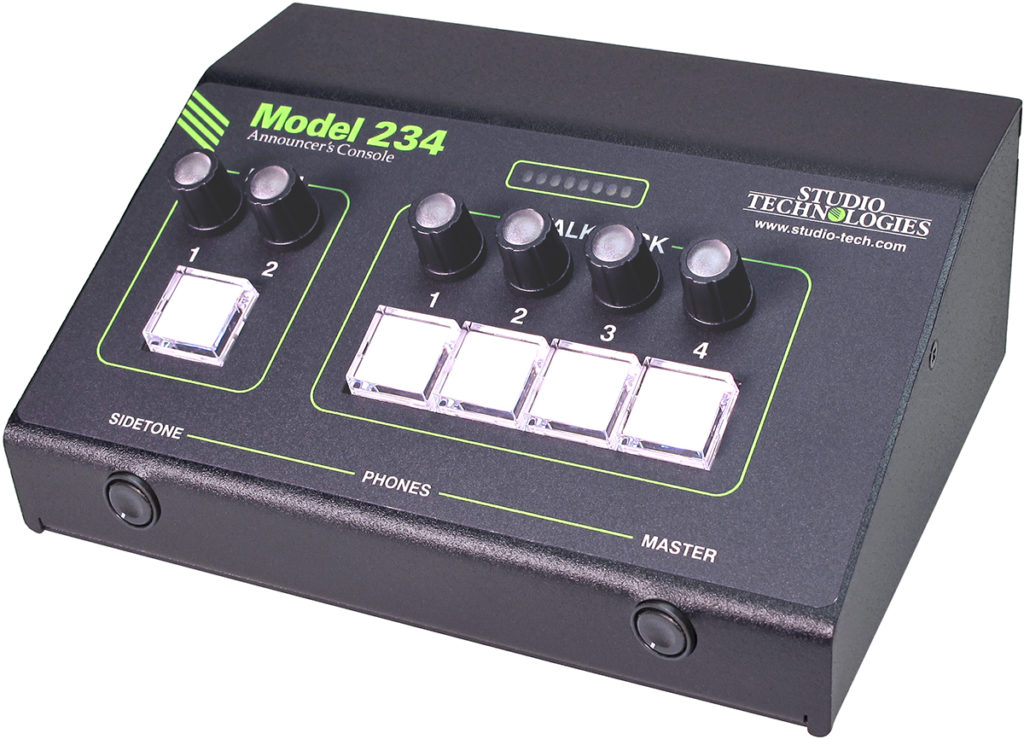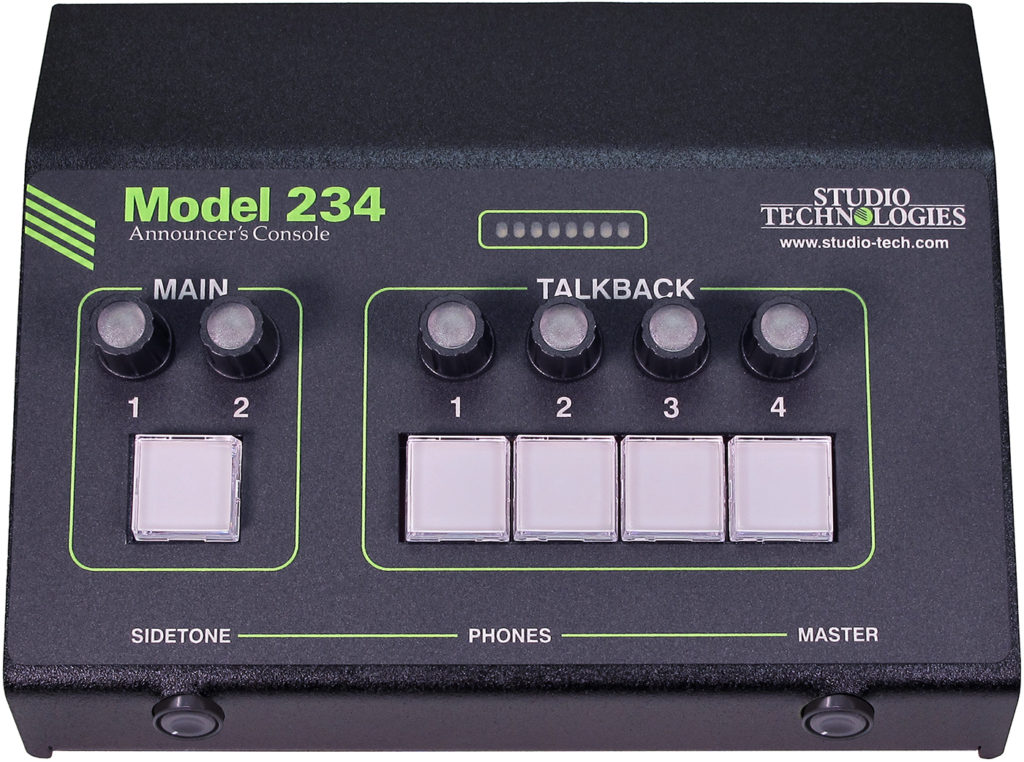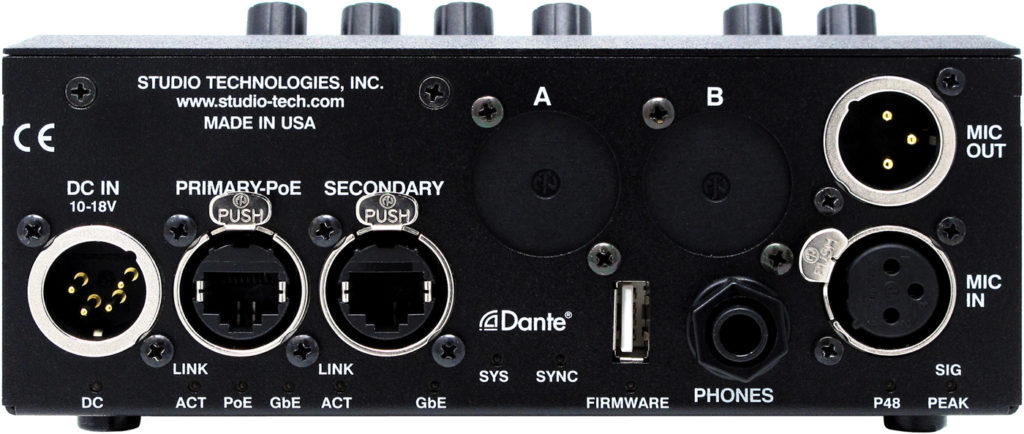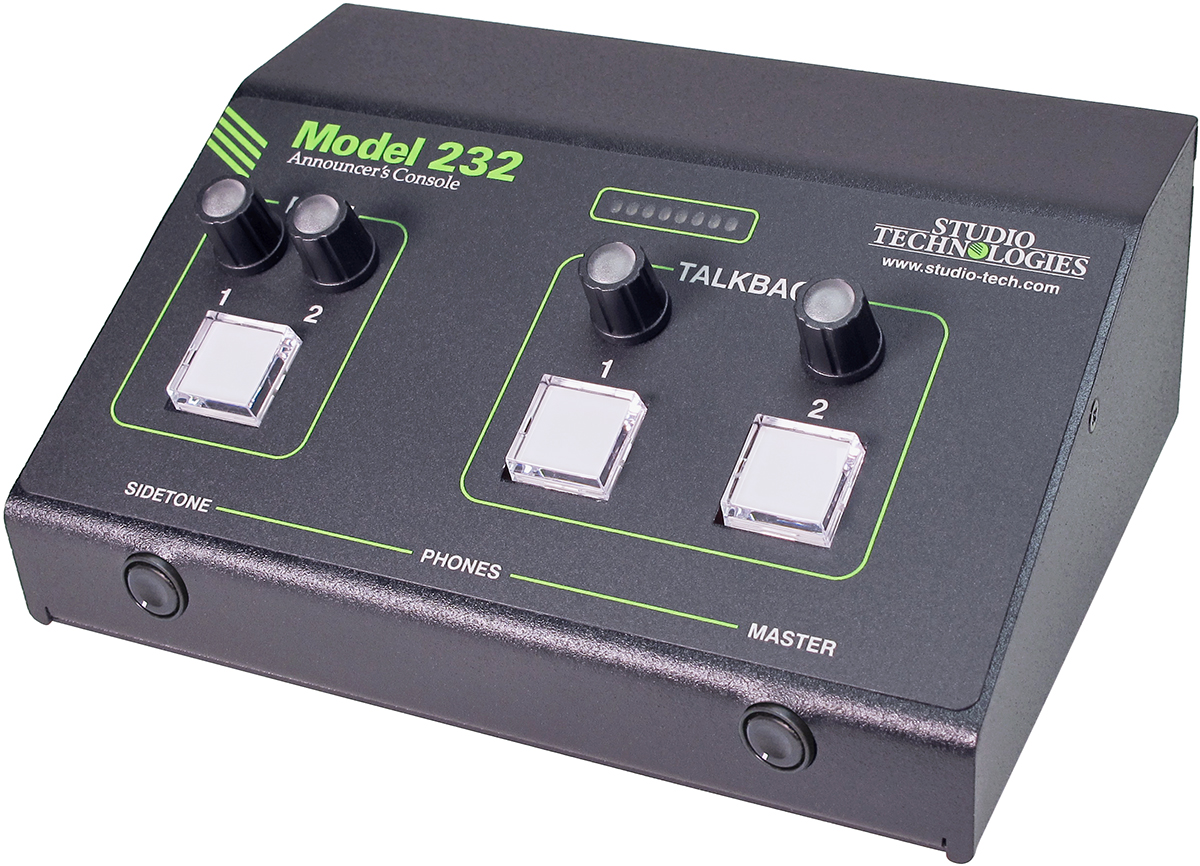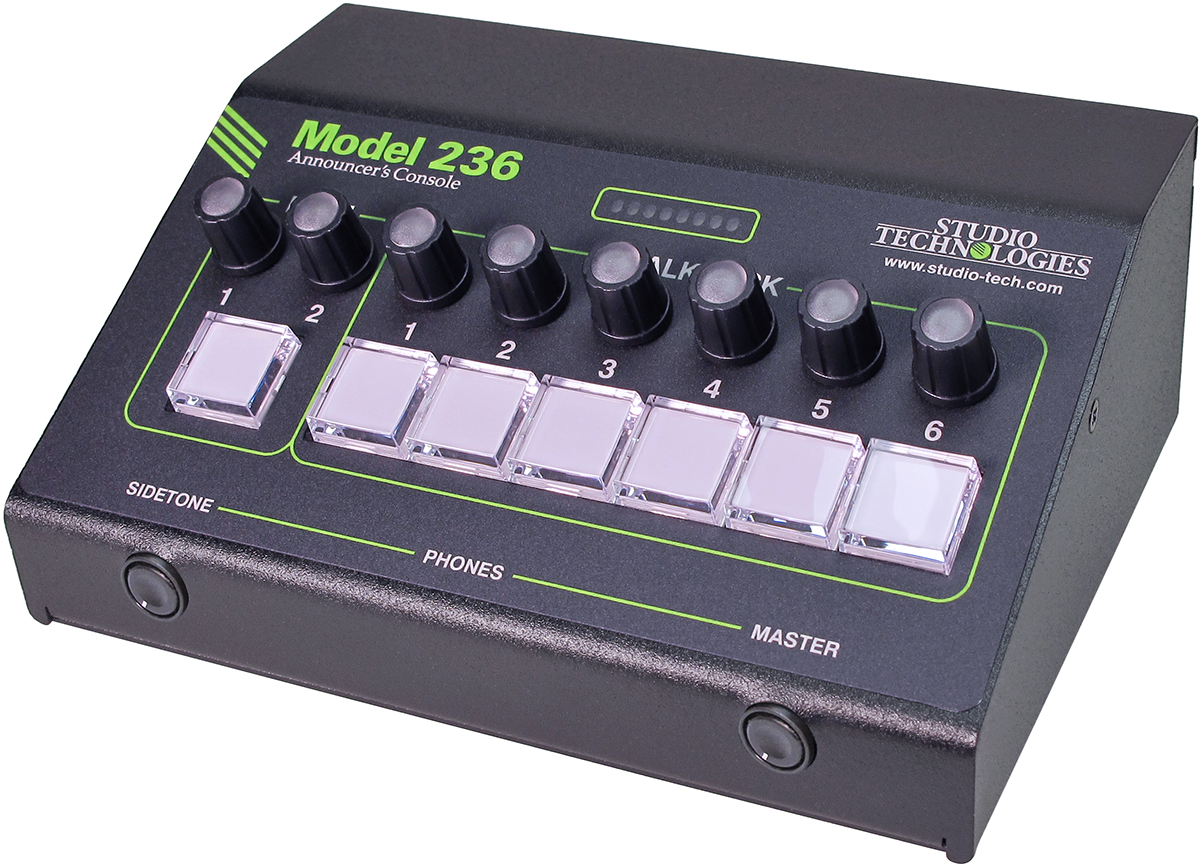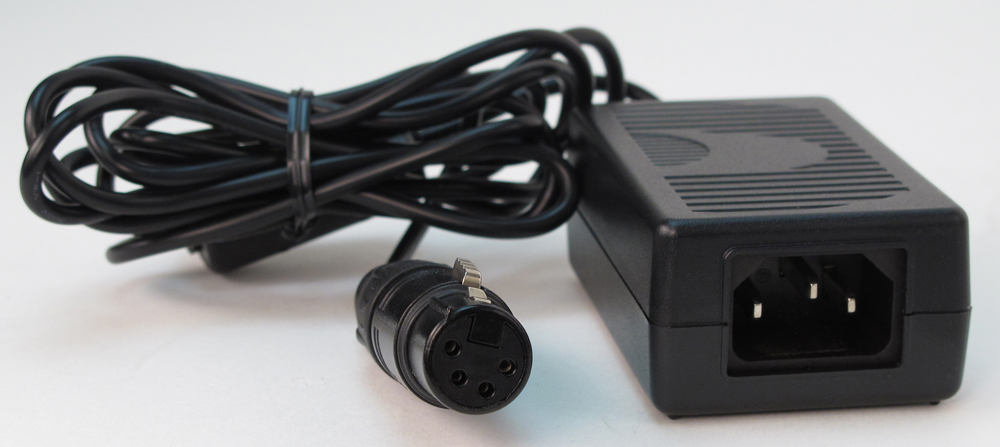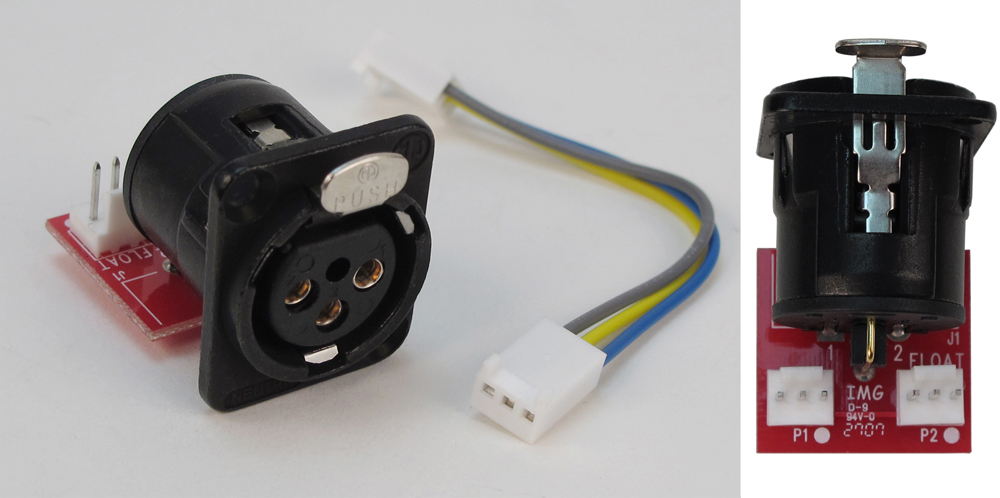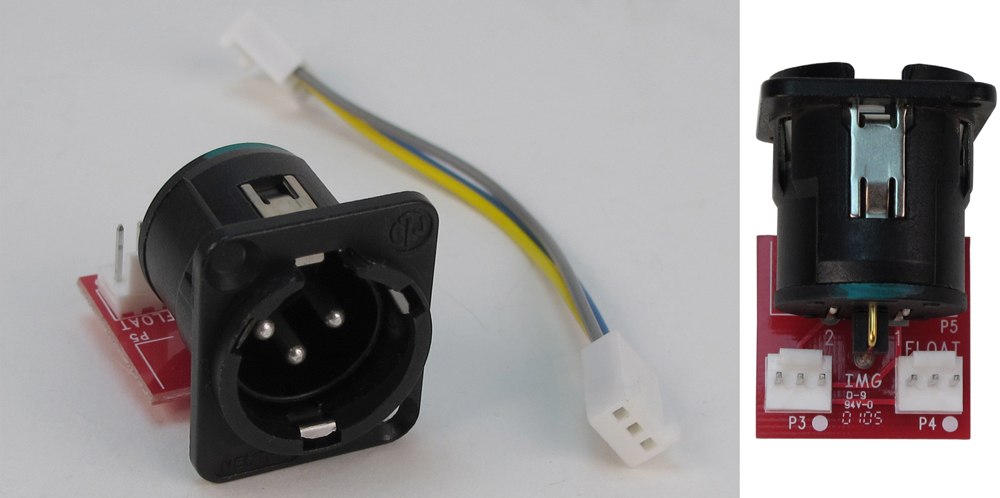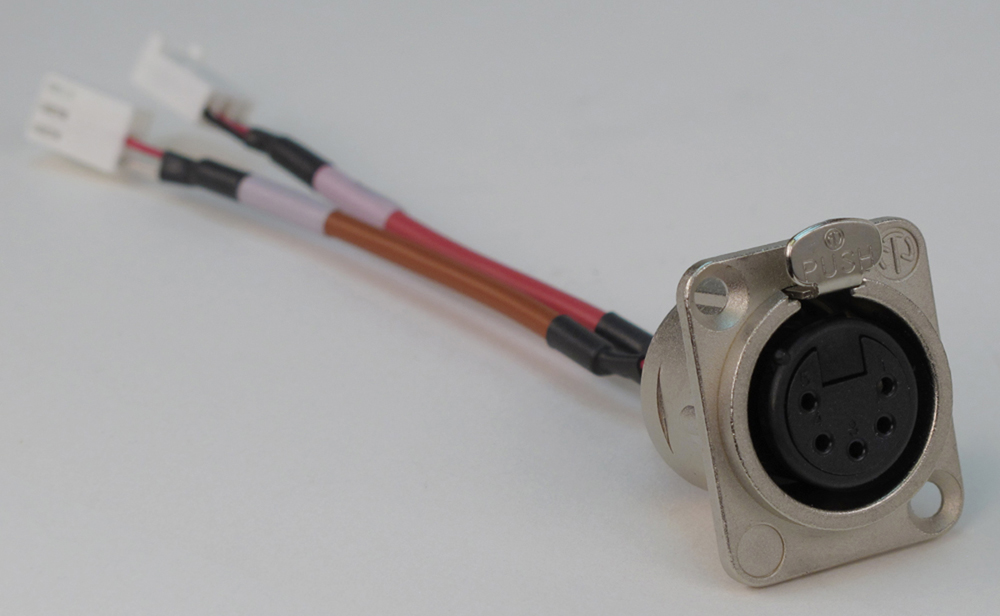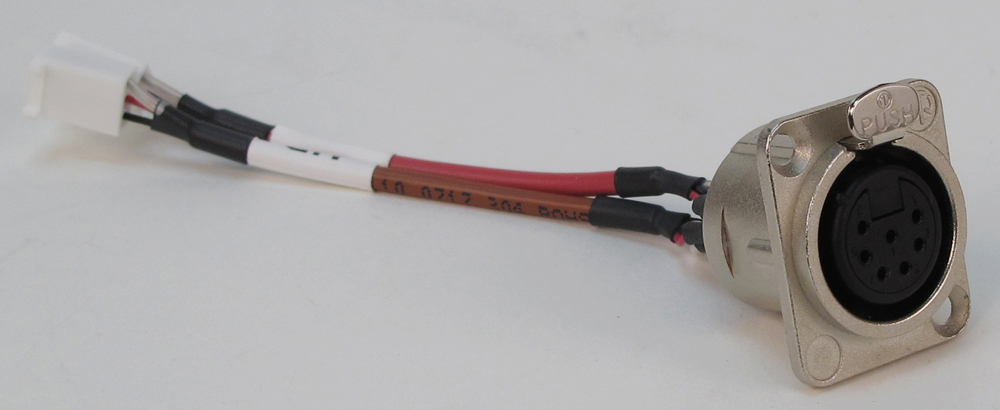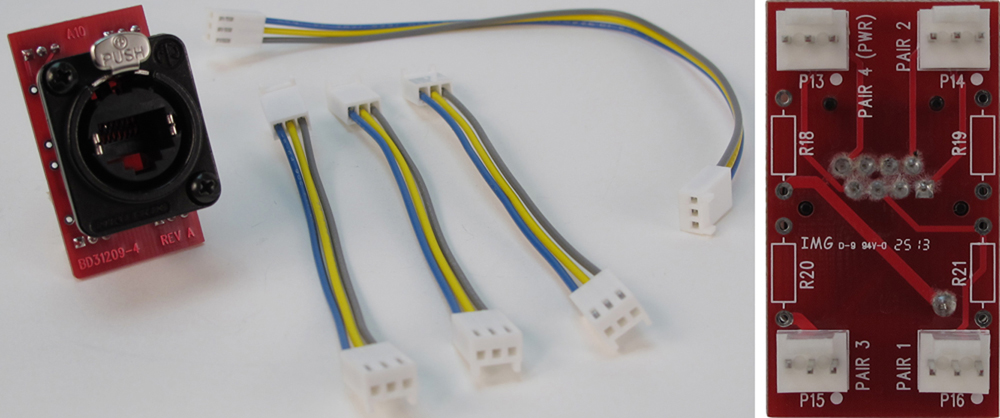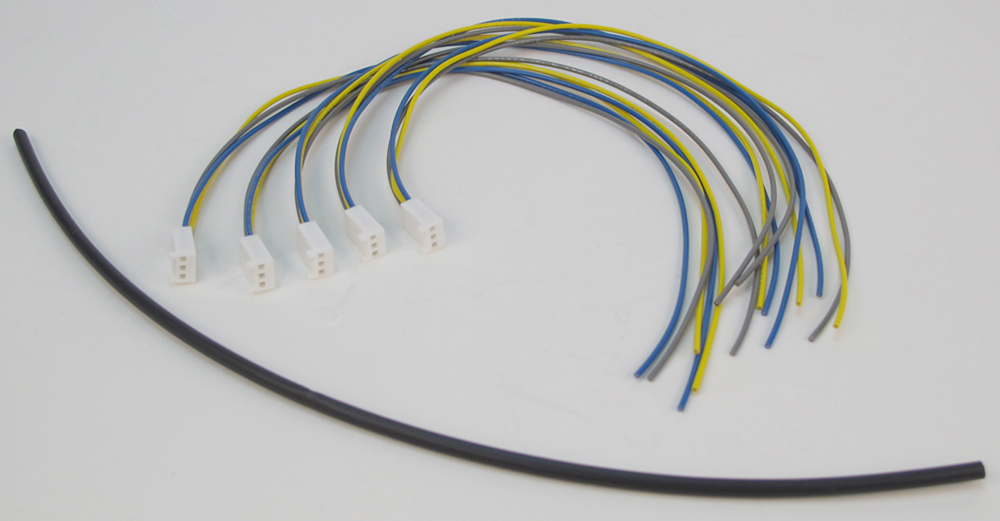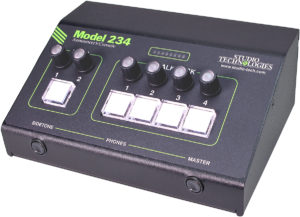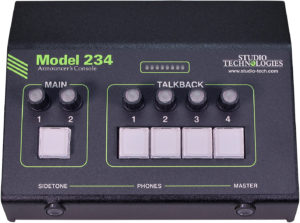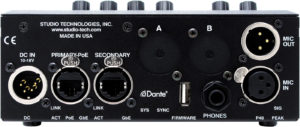The Model 234 Announcer's Console provides a combination of high-performance audio with an extensive set of user features and configurable resources. The unit is intended for use in demanding broadcast sports, eSports, live event, entertainment, and streaming broadcast applications. With a few simple connections the Model 234 can provide one on-air talent with all the resources they need to support a wide range of applications. The compact, rugged steel enclosure is intended for tabletop use, small enough for use "court-side" or in a crowded booth, yet flexible enough for remote production deployment. The Model 234 supports Dante® audio-over-Ethernet digital media technology with AES67 compatibility for integration into contemporary applications.
The Model 234 can integrate directly into both Dante audio-over-Ethernet and standard analog audio environments. With just a Power-over-Ethernet (PoE) Gigabit network connection, a microphone, and a pair of headphones a complete broadcast on-air position can be created. With the addition of a second Ethernet connection Redundant Dante can be supported. And by using the Model 234's analog microphone output a connection to a microphone-level input on an associated remote I/O interface or audio console can be supported.
With eight Dante audio inputs and an integrated sidetone function, users can easily create their desired headphone audio mix. They'll enjoy clear and "click-free" monaural or stereo audio that can only help their on-air performance. Four independent Dante talkback channels allow users to communicate with a variety of support personnel. Among the range of operating capabilities includes the ability to create talent cue (IFB) channels. This was specifically included for REMI/At-Home applications. Provision has been made such that a technician can "customize" the Model 234's hardware. Option kits, purchased separately, can be added to support functions such as multi-pin headset connectors, remote control inputs, and a low-voltage, low-current DC tally output.
The Model 234 was designed to meet two main goals: supporting great audio quality and providing an extensive set of configurable features. Using the latest in audio integrated circuits and advanced 32-bit audio processing, the unit's audio performance should meet or exceed that of any audio console, standalone microphone preamplifier, remote I/O interface, or outboard A/D or D/A converter. With over 40 years of professional audio experience, Studio Technologies takes audio performance seriously! And while providing excellent technical specifications is a "must," a device also has to "sound" good before we feel its design is complete.
The amount of flexibility provided in the Model 234 allows it to meet the needs of virtually all on-air announcer applications. And using the Studio Technologies' STcontroller software application makes "customizing" the operation of a Model 234 fast and simple. The unit's ability to handle both day-to-day and specialized situations makes it a unique product in the market. For example, the pushbutton switches and rotary encoders can be independently configured with multiple choices that range from simple to quite advanced. If a Model 234 can't seem to be configured to meet an application's goals please contact Studio Technologies' technical support for an application review.
The Model 234 is part of a three-product family that differ only in the number of talkback channels provided. The Model 234 provides four talkback channels, while the Model 232 provides two and the Model 236 provides six. The Model 234, as with the other two models, has a compact enclosure with overall dimensions of 6.5 inches wide (16.5 cm), 2.9 inches high (7.4 cm), and 4.9 inches deep (12.5 cm). Weighing 2.1 pounds (0.95 kg), the enclosure is made of steel to provide some "heft" to minimize the chance of inadvertent movement. The Model 234's main, secondary, and FPGA (programmable logic) firmware can be updated using the USB port on the back of the unit; the Dante firmware can be updated via an Ethernet connection.
Setup, Configuration, and Operation
Set up, configuration, and operation of the Model 234 is simple. The unit includes two Neutrik etherCON RJ45 connectors which allow interfacing with single or redundant Gigabit Ethernet networks. The primary network connection can provide power to the unit using a port on a Power-over-Ethernet (PoE) network switch. Model 234's power can also be supplied from a 12 volt DC source that is connected using a 4-pin XLR connector. A broadcast headset or handheld ("stick") microphone can be directly connected to the unit's 3-pin female XLR microphone input connector. The input is compatible with dynamic or condenser microphones. A P48 phantom power source allows support for a wide range of condenser microphones. A 3-pin male XLR connector provides an analog microphone output for integration with inputs on related devices. A configuration choice allows this output to be active all the time (hot mic operation) or muted or unmuted following the main output function. A pair of stereo headphones, the headphone connection from a stereo or monaural headset, or even earbuds can be connected to the Model 234's headphone output jack.
Audio signals are routed to and from the Model 234 using the Dante Controller software application. This is available, free of charge, from Audinate®, the creators of Dante. All Model 234 operating features are configured using the Studio Technologies' STcontroller software application. The extensive set of parameters allows the unit's functions to be tailored to meet the needs of many, many applications. STcontroller is available at no charge from the Studio Technologies' website. Versions are available that are compatible with the Windows® and macOS® operating systems. STcontroller is a fast and simple means of configuring, revising, saving, and loading a unit's operating parameters.
The Model 234's front panel includes six rotary controls (encoders) which are used to adjust the level of the Dante input signal sources as they create an audio mix that is fed to both the analog and Dante digital headphone outputs. Using RGB (red-green-blue) LEDs, each rotary encoder is illuminated and can display whether or not signal is present on their associated audio input channels. Two additional rotary controls allow adjustment of sidetone level and the overall level of the analog headphone output.
Five pushbutton switches allow the user to control the status of the main outputs (digital and analog) as well as the four talkback functions. Extensive configuration choices allow the operation of the pushbutton switches and associated output channels to be optimized to meet the needs of specific applications. For example, the talkback functions can be independently configured for talkback, talent cueing (IFB), call signal (20 kHz tone), and other related actions.
The Model 234's one main and four talkback pushbutton switches are illuminated to display their operating status. For performance confirmation an integrated sidetone function allows audio coming from the headset's microphone to be returned to the headset output.
Audio Quality
The Model 234's audio performance is completely "pro." A low-noise, wide dynamic-range microphone preamplifier ensures that microphone audio quality is preserved while minimizes the chance of signal overload. The gain of the microphone preamplifier can be adjusted over a range of 20 to 65 dB in 1-dB steps. A digitally controlled analog limiter function allows the signal level to be automatically adjusted to reduce the chance of signal overload. A setting in STcontroller allows the limiter function to be enabled or disabled as desired. The limiter function applies only to signals that are connected to the analog microphone input.
The output of the microphone preamplifier is routed to an analog-to-digital conversion (ADC) section that supports sampling rates of 48 and 96 kHz. The audio signal, now in the digital domain, routes through a 32-bit microprocessor and associated programmable logic and then on to the Dante interface section where it is packetized and prepared for transport over Ethernet. Eight Dante transmitter (output) channels are provided: one main, one aux, four talkback, and two headphone monitor output channels.
Audio input signals arrive into the Model 234 by way of nine Dante receiver (input) channels and pass into the Model 234's 32-bit logic circuitry. Four channels are associated with the main section, four are used for the talkback listen sources, and one can serve as an alternate microphone audio source. In addition to being used for typical headphone monitoring, the audio input associated with each talkback channel can be used as part of a talent cue (IFB) function. All channel routing, headphone level control, signal detection, and sidetone functions are performed within the digital domain. This preserves audio quality, enhances performance, and provides flexibility, allowing precise level control and mixing as well as eliminating the need for analog audio signals to pass through passive level controls (potentiometers). The audio signals destined for the analog headphone output are sent to a high-performance 2-channel digital-to-analog converter and then on to robust driver circuitry.
Dante Audio-over-Ethernet
Audio data is sent to and received from the Model 234 using Dante audio-over-Ethernet media networking technology. As a Dante-compliant device, the Model 234's eight Dante transmitter (output) channels and nine Dante receiver (input) channels can be assigned (routed or "subscribed") using the Dante Controller software application. To minimize the chance of a flow limitation, the Model 234's Dante transmitter and receiver channels support 32 Dante flows, 16 in each direction. The digital audio's bit depth is up to 32 with a sample rate of 48 or 96 kHz. Bi-color LEDs, located on the unit's back panel, provide status indications related to the Ethernet network and Dante interface performance.
The Model 234 is compliant with the AES67 interoperability standard. In addition, the unit is compatible with Audinate's Dante Domain Manager™ (DDM) software application. DDM offers an enhanced set of network control and monitoring features, making it ideal for security-conscious applications. This may also allow the Model 234's audio channels to support SMPTE® ST 2110-30.
Ethernet Data and PoE
The Model 234 connects to one or two local area networks (LANs) by way of two Gigabit (GigE) twisted-pair Ethernet interfaces. These 1000BASE-T interconnections are made by way of Neutrik® etherCON RJ45 connectors. While compatible with standard RJ45 plugs, etherCON allows a ruggedized and locking interconnection for harsh or high-reliability environments. The two Ethernet interfaces can be configured, using the Dante Controller software applications, to serve in the Dante Switched or Redundant modes.
The Model 234's operating power can be provided by way of its Primary-PoE Ethernet interface using the 802.3af Power-over-Ethernet (PoE) standard. PoE allows fast and efficient interconnection with an associated data network. Alternately, an external source of nominal 12 volts DC can be connected to power the unit. If both are connected then PoE will serve as the active power source.
Future Capabilities and Firmware Updating
The Model 234 was designed so that in the future its capabilities and performance can be easily enhanced. A USB type A connector, located on the unit's back panel, allows the main, secondary, and FPGA firmware files to be updated using a USB flash drive. The Model 234 uses the Broadway™ integrated circuit from Audinate to implement its Dante interface. The firmware in this integrated circuit can be updated via an Ethernet connection helping to ensure that its capabilities remain up to date.

